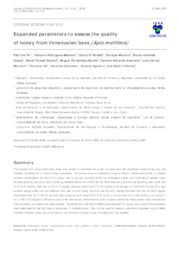Expanded parameters to assess the quality of honey from Venezuelan bees (Apis mellifera).
Expanded parameters to assess the quality of honey from Venezuelan bees (Apis mellifera).
Author(s): VIT, P.; RODRÍGUEZ-MALAVER, A.; ROUBIK, D. W.; MORENO, E.; SOUZA, B. de A.; SANCHO, M. T.; FERNÁNDEZ-MUIÑO, M.; ALMEIDA-ANACLETO, D.; MARCHINI, L. C.; GIL, F.; GONZÁLEZ, C.; AGUILERA, G.; NIEVES, B.
Summary: Hive samples from seven Venezuelan states were studied to determine the quality of honeys from the naturalized tropical honey bee Apis mellifera, submitted for a national honey competition. The physicochemical composition varied as follows: antibacterial activity as minimal inhibitory concentration for each of S. aureus and E. coli was 25.0-50.0 g/100 mL, antioxidant activity was 34.90-203.21 ?moles Trolox equivalents/100 g, ash was 0.03-0.13 g/100 g, diastase activity was 3.00-47.81 DN, flavonoids was 2.32-14.41 mg EQ/100 g, free acidity was 24.40-54.55 meq/kg, HMF was 17.70-631.73 mg/kg, moisture content was 17.2-20.2 g/100 g and nitrogen was 28.68-107.29 mg/100 g. Non aromatic organic acids, such as D-gluconic acid, was 13.5-69.3 g/kg, citric acid was 8.0-135.4 mg/kg, and malic acid was 11.2-60.9 mg/kg. Polyphenols were 38.15-182.10 mg EGA/100g, reducing sugars were 62.05-77.57 g/100 g, sucrose was 0.93-13.86 g/100 g, and vitamin C was 12.86-37.05 mg/100 g. Botanical origins of the nine honeys, determined by pollen analysis, indicate that these honeys often were derived from non-forest, non-native and weedy species. The results are a first step to better characterisation of honeys, and some of the parameters were determined for the first time in Venezuelan A. mellifera honey. They can be used for research, educational purposes, and to better understand market values, natural occurrence and chemistry of tropical honey harvested from Apis mellifera.
Publication year: 2009
Types of publication: Journal article
Unit: Embrapa Mid-North
Observation
Some of Embrapa's publications are published as ePub files. To read them, use or download one of the following free software options to your computer or mobile device. Android: Google Play Books; IOS: iBooks; Windows and Linux: Calibre.
Access other publications
Access the Agricultural Research Database (BDPA) to consult Embrapa's full library collection and records.
Visit Embrapa Bookstore to purchase books and other publications sold by Embrapa.

